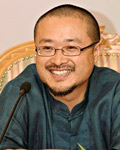| A Shanghai icon. The epitome of modern Chinese history. A panorama of various architecture styles. That's what usually comes to mind when talking about the Bund.
 |
|
Zhou Bing (1926CN.COM) |
However, documentary film maker Zhou Bing sees the Bund as a symbol of people's lust for money, power and love that mesh with the dreams of the city and the country.
Zhou's latest documentary film The Bund traces the historic area along the Huangpu River from 1843, when the British first established a concession in Shanghai, to 1945, when the Japanese, the last foreign occupants, left the city following their defeat in World War II.
"I want to overthrow some stereotypes and prejudices about Shanghai and show the essence of the city," says Zhou at the ongoing Shanghai International Film Festival, which will end this Sunday. Zhou is famous for his documentary The Forbidden City.
The Bund will be screened nationwide in August or September.
"If you really go into the living space of the city, you will find Shanghai is very different from what many think it is."
Instead of elaborating on a straight historical timeline of the Bund, the movie is divided into four acts. The first three explore the lives of six individuals. They are: Britain's Sir Robert Hart, Ningbo (Zhejiang Province) merchant Ye Chengzhong, controversial Shanghai gangster leader Du Yuesheng, Chinese actress Zhou Xuan, Hene Fano from France and China-born Japanese actress Yoshiko Yamaguchi (known as Li Xianglan in Chinese).
The common links between the six are the Bund and Shanghai.
"Each of the six individuals represents one aspect of Shanghai in my opinion," Zhou says.
The director adds that this approach of telling history through personal stories is an experiment for him.
"As the inspector general of China's Imperial Maritime Customs Service, Hart gave credibility to the concept in Shanghai. Fano was typical of many foreigners at that time who originally hoped to gain something from Shanghai but eventually left something to Shanghai. Together with Hudec, he left a legacy of artistic architecture in Shanghai.
"The struggles of Li Xianglan, on the other hand, show how people can be torn due to identity issues that many Shanghainese experience."
The last act wraps up the lives of the six individuals and ends with the haunted singing of Zhou Xuan, "a poor child who did not find her birth mother."
According to director Zhou, such a sense of insecurity and homelessness is something found in metropolises around the world, not just in Shanghai.
The Bund cost 13 million yuan ($1.9 million). An international version tailored to Western tastes will be aired on National Geographic Channel in several months.
(Shanghai Daily June 17, 2010) | 